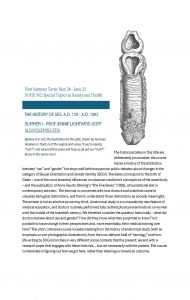SOHE 302
First Summer Term: May 28 – June 25
SOHE 302: Special Topics in Society and Health
THE HISTORY OF SEX, A.D. 129 – A.D. 1993
SUMMER I – PROF JENNIE LIGHTWEIS-GOFF (JLG@OLEMISS.EDU)
The historical dates in this title are deliberately provocative: the course traces a history of the distinction between “sex” and “gender” but stops well before expansive public debates about changes in the category of Sexual Orientation and Gender Identity (SOGI). The dates correspond to the birth of Galen – one of the most essential influences on classical medicine’s conceptions of the sexed body –and the publication of Anne Fausto-Sterling’s “The Five Sexes” (1993), a foundational text incontemporary activism. The seminar is concerned with how doctors and scientists came tovisualize biological distinctions, and then to understand those distinctions as socially meaningful.The answer is not as intuitive as we may think. Anatomical study is a comparatively new feature ofmedical education, and doctors routinely performed fully clothed physical examinations on womenuntil the middle of the twentieth century. We therefore consider the question historically – what diddoctors believe about sex and gender? How did they know what they purported to know? Is itpossible to trace change in their perspectives and, more essentially, their medical training overtime? This short, intensive course includes reading from the history of anatomical study (with anemphasis on pre-photographic illustrations), from the now-defunct field of “sexology,” and fromlife-writing by SOGI minorities in very different social contexts that the present; we end with aresearch paper that engages with these histories….but not necessarily with the present. The course is interested in figuring out how we got here, rather than steering us toward an outcome.
